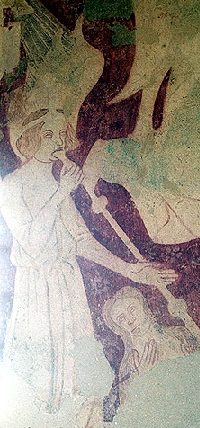The Doom, or Last Judgement
and the Weighing of Souls
An Introduction

After St Christopher, the Doom or Last Judgement was probably the subject most commonly painted in the Medieval parish church. The standard placing is above the Chancel Arch, because of the symbolism associated with the division between Nave and Chancel. This division within the Church, (considered both as actual building and as the Body of Christ) separated the priest’s domain in the chancel from that of the people in the nave, but it also symbolically marked the greater divide between the Church Militant (here on earth) and the Church Expectant (the souls in Purgatory), from the Church Triumphant in Heaven. But this placing is only standard, not invariable, and many Dooms are elsewhere in medieval churches; West Somerton, represented here, is one such.
The word ‘Doom’ in this context carries in itself no sense of disaster, or of eternal damnation; it is the ‘time of trial’, the blinking of an eye between time and eternity in which the individual soul’s fate is sealed, irrevocably. The Risen Christ, often showing the Wounds of the Crucifixion, always presides, usually at the centre of the painting. The Virgin Mary is usually present as she was at the Crucifixion – at Christ’s right hand and often kneeling in supplication for the souls awaiting their sentence. St John the Evangelist is commonly found, again often as a kneeling intercessor like the Virgin. There are usually attendant angels, and sometimes Apostles (St Peter is the most frequently found) and other Saints as well. The Instruments of the Passion – Cross, Scourge, Pillar of the Scourging, Crown of Thorns and so on – sometimes appear, often ‘presented’ to the onlooker by angels.
Below all this, individual souls rise, usually naked, from their graves and are shown entreating Christ and his Intercessors to save them. The long-haired woman beside the trumpeting angel above is shown doing precisely that.
In most cases the aftermath of the Judgement is shown, with groups of souls departing for ever to Heaven (generally on the left [north] or to Hell, on the right [south]). These scenes are often painted on the north & south nave walls immediately before these form a right-angle with the chancel arch wall. Saved souls may appear standing in line to be met by St Peter before passing into the apartments of Heaven beyond. Conversely, the damned proceed to Hell, assisted by devils and all the paraphernalia of Medieval hell-depictions, including, almost always, the Hell Mouth shown as the literally-painted gaping mouth of a Leviathan-like whale or sea creature.
The Weighing of Souls may be included as an integral part of the Doom, but some Weighings of Souls have either lost their Dooms or were presented as detached, if not actually separate, subjects from the first – Rotherfield, Slapton and South Leigh, are examples. Christ’s agent here is St Michael, holding the scales or balance in which individual souls are weighed against their sins. The Virgin may intervene on behalf of an endangered soul by putting her hand on the balance or her rosary in the scale-pan, as at Slapton. The links in the table below will take you to this and the other Dooms/Weighings here
Visions of the Last Day in medieval art generally tend to owe more to non-Biblical apocalyptic writing than they do to the difficult symbolism of Revelation or the Book of Daniel. Probably the best example is the Prick of Conscience window at All Saints, York, narrating the events of the Last Fifteen Days of the World as found in the work of St Jerome and that attributed to Richard Rolle of Hampole. But the Doom gave the medieval church-painter ample opportunity for imaginative graphic depiction of the end to which all flesh must come. This is not a subject that gives much scope for elegance or even for the pathos found in some other painted stories. Many English Dooms are quite crudely painted, and none even begin to approach the terrifying implacability of Michelangelo’s Judging Christ in the Sistine Chapel, Rome, although paintings not dissimilar to those here were of course part of Michelangelo’s heritage too. But no doubt the Doom in the English parish church was quite awesome enough, so far as the medieval parishioner was concerned.